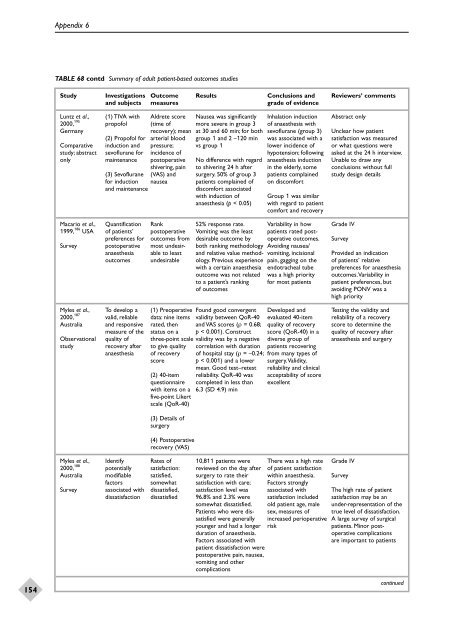Aanesthetic Agents for Day Surgery - NIHR Health Technology ...
Aanesthetic Agents for Day Surgery - NIHR Health Technology ...
Aanesthetic Agents for Day Surgery - NIHR Health Technology ...
Create successful ePaper yourself
Turn your PDF publications into a flip-book with our unique Google optimized e-Paper software.
154<br />
Appendix 6<br />
TABLE 68 contd Summary of adult patient-based outcomes studies<br />
Study Investigations Outcome Results Conclusions and Reviewers’ comments<br />
and subjects measures grade of evidence<br />
Luntz et al., (1) TIVA with Aldrete score Nausea was significantly Inhalation induction Abstract only<br />
2000, 195<br />
propofol (time of more severe in group 3 of anaesthesia with<br />
Germany recovery); mean at 30 and 60 min; <strong>for</strong> both sevoflurane (group 3) Unclear how patient<br />
(2) Propofol <strong>for</strong> arterial blood group 1 and 2 –120 min was associated with a satisfaction was measured<br />
Comparative induction and pressure; vs group 1 lower incidence of or what questions were<br />
study; abstract sevoflurane <strong>for</strong> incidence of hypotension; following asked at the 24 h interview.<br />
only maintenance postoperative No difference with regard anaesthesia induction Unable to draw any<br />
shivering, pain to shivering 24 h after in the elderly, some conclusions without full<br />
(3) Sevoflurane (VAS) and surgery. 50% of group 3 patients complained study design details<br />
<strong>for</strong> induction nausea patients complained of on discom<strong>for</strong>t<br />
and maintenance discom<strong>for</strong>t associated<br />
with induction of Group 1 was similar<br />
anaesthesia (p < 0.05) with regard to patient<br />
com<strong>for</strong>t and recovery<br />
Macario et al., Quantification Rank 52% response rate. Variability in how Grade IV<br />
1999, 186 USA of patients’ postoperative Vomiting was the least patients rated postpreferences<br />
<strong>for</strong> outcomes from desirable outcome by operative outcomes. Survey<br />
Survey postoperative most undesir- both ranking methodology Avoiding nausea/<br />
anaesthesia able to least and relative value method- vomiting, incisional Provided an indication<br />
outcomes undesirable ology. Previous experience pain, gagging on the of patients’ relative<br />
with a certain anaesthesia endotracheal tube preferences <strong>for</strong> anaesthesia<br />
outcome was not related was a high priority outcomes.Variability in<br />
to a patient’s ranking <strong>for</strong> most patients patient preferences, but<br />
of outcomes avoiding PONV was a<br />
high priority<br />
Myles et al., To develop a (1) Preoperative Found good convergent Developed and Testing the validity and<br />
2000, 187<br />
valid, reliable data: nine items validity between QoR-40 evaluated 40-item reliability of a recovery<br />
Australia and responsive rated, then and VAS scores (ρ = 0.68; quality of recovery score to determine the<br />
measure of the status on a p < 0.001). Construct score (QoR-40) in a quality of recovery after<br />
Observational quality of three-point scale validity was by a negative diverse group of anaesthesia and surgery<br />
study recovery after to give quality correlation with duration patients recovering<br />
anaesthesia of recovery of hospital stay (ρ = –0.24; from many types of<br />
score p < 0.001) and a lower surgery.Validity,<br />
mean. Good test–retest reliability and clinical<br />
(2) 40-item reliability. QoR-40 was acceptability of score<br />
questionnaire completed in less than excellent<br />
with items on a 6.3 (SD 4.9) min<br />
five-point Likert<br />
scale (QoR-40)<br />
(3) Details of<br />
surgery<br />
(4) Postoperative<br />
recovery (VAS)<br />
Myles et al., Identify Rates of 10,811 patients were There was a high rate Grade IV<br />
2000, 188<br />
potentially satisfaction: reviewed on the day after of patient satisfaction<br />
Australia modifiable satisfied, surgery to rate their within anaesthesia. Survey<br />
factors somewhat satisfaction with care; Factors strongly<br />
Survey associated with dissatisfied, satisfaction level was associated with The high rate of patient<br />
dissatisfaction dissatisfied 96.8% and 2.3% were satisfaction included satisfaction may be an<br />
somewhat dissatisfied. old patient age, male under-representation of the<br />
Patients who were dis- sex, measures of true level of dissatisfaction.<br />
satisfied were generally increased perioperative A large survey of surgical<br />
younger and had a longer risk patients. Minor postduration<br />
of anaesthesia. operative complications<br />
Factors associated with<br />
patient dissatisfaction were<br />
postoperative pain, nausea,<br />
vomiting and other<br />
complications<br />
are important to patients<br />
continued
















